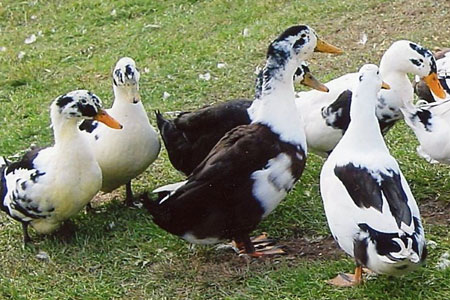
The Ancona duck originated in the 1910s, yet remains a rare breed that has never been listed in the American Standard of Perfection. Cackle Hatchery® is one of its few long-term breeders, having maintained Ancona genetics since 1977.
Physical Attributes
Anconas are typically white and black, or any combination of white and color, in irregular splotches. This breed is unique among ducks for having mottled plumage with no specific pattern. In other words, no two are alike. In this regard, the Ancona has been compared to a Holstein cow that quacks.
On average, the Ancona’s plumage is about three-quarters white and one-quarter black, although color increases with age. The neck, however, usually remains solid white.
Cackle Hatchery’s Ancona ducks are most often white and black, although an occasional individual will have chocolate markings. Chocolate results from a recessive sex-link trait passed down only by drakes.
A black drake mated to a black hen results in mostly black offspring, although a few may be chocolate. A black drake mated to a chocolate hen also results in mostly black offspring, although again some may be chocolate.
A chocolate drake mated to a black hen results in all black males and all chocolate females. So you can easily determine which ducklings are male and which are female at the time of hatch. To get 100% chocolate offspring requires mating a chocolate drake to a chocolate hen.
Breed Qualities
Anconas are dual-purpose egg-and-meat ducks. They are one of the best layers among ducks, producing 210 to 280 large eggs per year. The shell colors are just as interesting as the ducks themselves — the shells may be white, ivory, blue-green, or speckled.
Ancona hens tend not to brood, and when they do they are only fair mothers. A serious breeder might therefore wish to invest in an incubator.
As meat birds, Anconas have a stocky build and a rapid rate of growth, being ready for harvest in just 7 to 8 weeks. Their lean meat is less fatty than that of a Pekin, yet Anconas (with mostly white feathers) are not much more difficult to pluck. Hens grow to 7 pounds, drakes to 8 pounds.
The Ancona is an excellent forager that especially relishes pesky slugs, but also readily chows down on bugs and worms, and weeds and seeds. This duck is too heavy to fly, making it is easy to confine. And its hefty weight deters flying predators, making it a good choice for free ranging. With its exceptionally calm disposition, the Ancona duck also makes an outstanding pet.
Helpful Links
- Keeping Ducks for Eggs
- How to Keep Your Ducks Laying Well
- How the Eggs of Chickens, Turkeys, Ducks and Geese Compare
- How to Handle Duck Eggs for Eating
And that’s today’s news from the Cackle Coop.
Gail Damerow is the author of An Absolute Beginner’s Guide to Raising Backyard Ducks : Breeds, Feeding, Housing and Care, Eggs and Meat.

